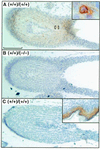Failure of ductus arteriosus closure and remodeling in neonatal mice deficient in cyclooxygenase-1 and cyclooxygenase-2
- PMID: 11158594
- PMCID: PMC14708
- DOI: 10.1073/pnas.98.3.1059
Failure of ductus arteriosus closure and remodeling in neonatal mice deficient in cyclooxygenase-1 and cyclooxygenase-2
Abstract
The transition to pulmonary respiration following birth requires rapid alterations in the structure of the mammalian cardiovascular system. One dramatic change that occurs is the closure and remodeling of the ductus arteriosus (DA), an arterial connection in the fetus that directs blood flow away from the pulmonary circulation. A role for prostaglandins in regulating the closure of this vessel has been supported by pharmacological and genetic studies. The production of prostaglandins is dependent on two cyclooxygenases (COX-1 and COX-2), which are encoded by separate genes. We report here that the absence of either or both COX isoforms in mice does not result in premature closure of the DA in utero. However, 35% of COX-2(-/-) mice die with a patent DA within 48 h of birth. In contrast, the absence of only the COX-1 isoform does not affect closure of the DA. The mortality (35%) and patent DA incidence due to absence of COX-2 is, however, significantly increased (79%) when one copy of the gene encoding COX-1 is also inactivated. Furthermore, 100% of the mice deficient in both isoforms die with a patent DA within 12 h of birth, indicating that in COX-2-deficient mice, the contribution of COX-1 to DA closure is gene dosage-dependent. Together, these data establish roles for COX-1, and especially for COX-2, in the transition of the cardiopulmonary circulation at birth.
Figures



References
-
- Smith G C S. Pharmacol Rev. 1998;50:35–58. - PubMed
-
- Gersony W M. Pediatr Clin North Am. 1986;33:545–560. - PubMed
-
- Smith W L, DeWitt D L. Adv Immunol. 1996;62:167–215. - PubMed
-
- Vane J R. Nat New Biol. 1971;231:232–235. - PubMed
-
- Bhattacharya M, Asselin P, Hardy P, Guerguerian A M, Shichi H, Hou X, Varma D R, Bouayad A, Fouron J C, Clyman R I, et al. Circulation. 1999;100:1751–1756. - PubMed
Publication types
MeSH terms
Substances
Grants and funding
LinkOut - more resources
Full Text Sources
Medical
Molecular Biology Databases
Research Materials

